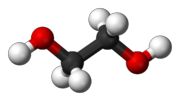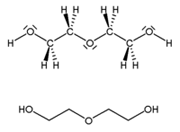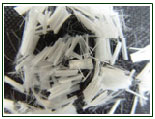|
MONOETHYLENE GLYCOL (MEG)
Chemical Formula : C2H6O2
CAS Registry Number : 107-21-1
|
DIETTHYLENE GLYCOL (DEG)
Chemical Formula : C4H10O2
CAS Registry Number : 114-46-6
|
|
 Ethylene glycol is an organic compound widely used as an automotive antifreeze and a precursor to polymers. In its pure form, it is an odorless, colorless, syrupy, sweet-tasting liquid. Ethylene glycol is toxic, and ingestion can result in death. Ethylene glycol is an organic compound widely used as an automotive antifreeze and a precursor to polymers. In its pure form, it is an odorless, colorless, syrupy, sweet-tasting liquid. Ethylene glycol is toxic, and ingestion can result in death. Production Production
Ethylene glycol is produced from ethylene (ethene), via the intermediate ethylene oxide. Ethylene oxide reacts with water to produce ethylene glycol according to the chemical equation:
C2H4O + H2O → HOCH2CH2OH
This reaction can be catalyzed by either acids or bases, or can occur at neutral pH under elevated temperatures. The highest yields of ethylene glycol occur at acidic or neutral pH with a large excess of water. Under these conditions, ethylene glycol yields of 90% can be achieved. The major byproducts are the ethylene glycol oligomers diethylene glycol, triethylene glycol, and tetraethylene glycol.
Applications
Monoethylene Glycol (MEG) can be used for applications that require chemical intermediates for resins, solvent couplers, freezing point depression, solvents, humectants and chemical intermediates. These applications are vital to the manufacture of a wide range of products, including resins; deicing fluids; heat transfer fluids; automotive antifreeze and coolants; water-based adhesives, latex paints and asphalt emulsions; electrolytic capacitors; textile fibers; paper and leather.
|
|
|




